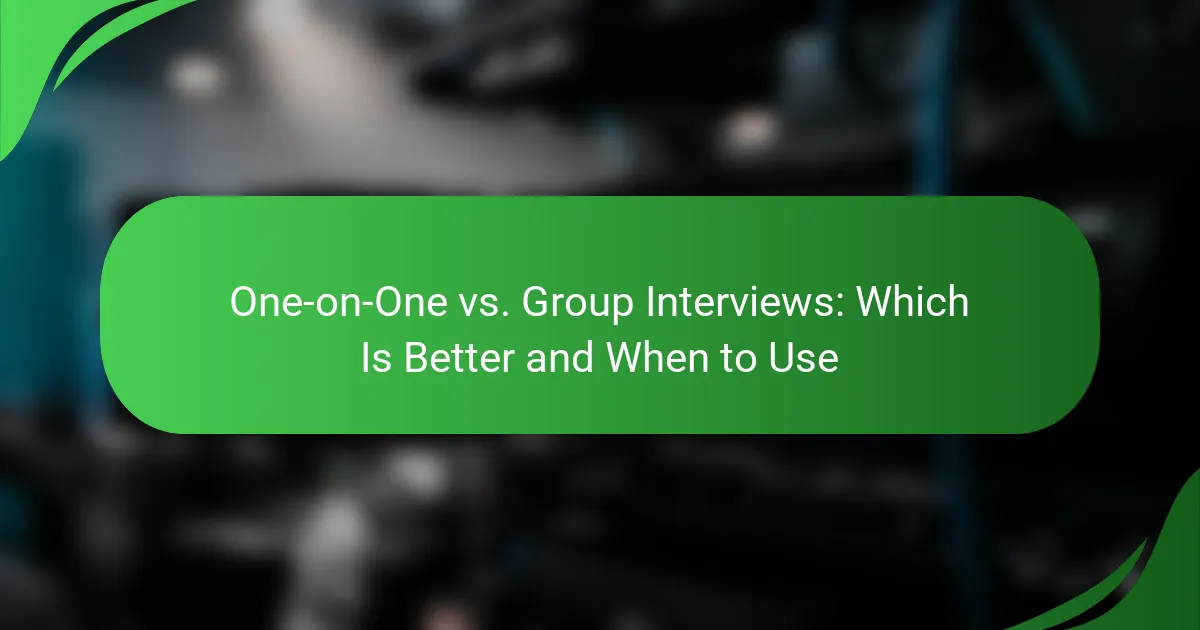Sports interviews have evolved into a dynamic medium, utilizing various formats such as video, podcasts, and live Q&A sessions to engage fans and deliver unique insights. By incorporating innovative methods, these interviews not only enhance the viewing experience but also foster deeper connections between athletes and their audience. Through these conversations, valuable perspectives on player mindsets, team dynamics, and coaching strategies come to light, enriching the overall understanding of the sport.

What are the popular formats for sports interviews in the UK?
In the UK, popular formats for sports interviews include video interviews, podcasts, live Q&A sessions, written articles, and social media interactions. Each format offers unique advantages and caters to different audience preferences, making them effective for engaging fans and delivering insights.
Video interviews
Video interviews are a dynamic way to engage audiences, often featuring athletes discussing their experiences, training regimens, or upcoming events. These interviews can be broadcast on television or shared on platforms like YouTube, providing a visual connection that enhances viewer engagement.
When conducting video interviews, consider the setting and lighting to ensure clarity. Short, focused segments typically work best, keeping the content engaging and digestible for viewers.
Podcast interviews
Podcast interviews have gained popularity due to their convenience, allowing listeners to consume content while multitasking. They often feature in-depth discussions with athletes, coaches, or analysts, providing valuable insights into the sports world.
To create a successful podcast, focus on quality audio and a clear format. Regular episodes help build an audience, and inviting guests with diverse perspectives can enrich the content.
Live Q&A sessions
Live Q&A sessions allow fans to interact directly with athletes or sports personalities, creating an engaging experience. These sessions can take place on platforms like Instagram Live or Twitter Spaces, where participants can ask questions in real-time.
To maximize engagement, promote the session in advance and encourage fans to submit questions. Keeping the session interactive and responsive can enhance the overall experience for both the athlete and the audience.
Written articles
Written articles provide a traditional yet effective format for sports interviews, often published in newspapers, magazines, or online platforms. They allow for detailed storytelling and analysis, giving readers a comprehensive view of the subject’s thoughts and experiences.
When writing articles, focus on clarity and structure. Use quotes effectively to capture the interviewee’s voice and ensure the article flows logically, making it easy for readers to follow the narrative.
Social media interviews
Social media interviews leverage platforms like Twitter, Instagram, or Facebook to engage fans in a more casual format. These interviews can take the form of text-based Q&As, short video clips, or live streams, making them highly accessible.
To succeed in social media interviews, keep the content concise and visually appealing. Use hashtags and tags to increase visibility and encourage audience participation, fostering a sense of community around the sport.

How do unique methods enhance sports interviews?
Unique methods enhance sports interviews by creating more engaging and immersive experiences for both the interviewee and the audience. These approaches can lead to richer insights, foster deeper connections, and offer fans a more interactive way to engage with their favorite athletes.
Interactive fan engagement
Interactive fan engagement transforms traditional interviews by allowing fans to participate directly. This can include live Q&A sessions, polls, or social media interactions where fans submit questions in real-time. Such methods not only increase viewer investment but also provide athletes with immediate feedback from their audience.
Platforms like Instagram Live or Twitter Spaces have become popular for these interactions, enabling athletes to connect with fans on a personal level. This approach can significantly boost an athlete’s popularity and strengthen their brand by showcasing their personality beyond the field.
Behind-the-scenes access
Behind-the-scenes access offers fans a glimpse into the lives of athletes beyond their public personas. This can include pre-game rituals, training routines, or personal stories that reveal their motivations and challenges. Such insights can humanize athletes, making them more relatable to fans.
For instance, a documentary-style interview that follows an athlete through a season can provide context to their performance and decisions. This method not only enriches the narrative but also builds a stronger emotional connection between the athlete and their supporters.
Virtual reality experiences
Virtual reality (VR) experiences take sports interviews to a new level by immersing fans in a 360-degree environment. This technology allows viewers to feel as if they are sitting next to the athlete during the interview, enhancing the overall experience. VR can simulate game-day environments or training sessions, providing unique perspectives that traditional interviews cannot offer.
While still emerging, VR interviews can be particularly effective for engaging younger audiences who are more tech-savvy. As VR technology becomes more accessible, integrating it into sports interviews could redefine how fans interact with their favorite athletes.

What key insights can be gained from sports interviews?
Sports interviews provide valuable insights into the mindset of players, the dynamics within teams, and the strategies employed by coaches. These interviews can reveal personal motivations, team chemistry, and tactical approaches that may not be visible during games.
Player perspectives
Player perspectives in interviews often highlight individual experiences and thoughts on performance, motivation, and challenges. Understanding these insights can help fans and analysts appreciate the mental and emotional aspects of the game. For example, a player discussing their preparation routine can shed light on the importance of mental focus and physical conditioning.
Additionally, players may share their views on team culture and leadership, which can influence overall performance. Recognizing how players perceive their roles can provide a deeper understanding of team dynamics and individual contributions.
Team dynamics
Team dynamics are crucial for success in sports, and interviews can reveal how players interact and collaborate. Insights into communication styles, trust levels, and conflict resolution among teammates can be gained through candid discussions. For instance, a player might describe how open dialogue fosters a supportive environment, enhancing team cohesion.
Moreover, interviews can uncover the impact of leadership on team dynamics. Players often discuss how captains or veteran members influence morale and performance, which can be a deciding factor in high-pressure situations.
Coaching strategies
Coaching strategies are often illuminated through interviews, where coaches explain their game plans, adjustments, and philosophies. These insights can help fans and aspiring coaches understand the tactical decisions made during games. For example, a coach might detail how they adapt strategies based on opponent strengths and weaknesses.
Furthermore, interviews can reveal the importance of player development and training methods. Coaches may discuss how they tailor their approaches to individual players, emphasizing the need for flexibility in coaching styles to maximize team potential.

What criteria should be considered when selecting interview formats?
When selecting interview formats, consider the audience’s preferences, the channels for content distribution, and the resources available for production. Each of these criteria plays a crucial role in determining the effectiveness and reach of the interview.
Audience preferences
Understanding audience preferences is essential for selecting the right interview format. Different demographics may favor various styles, such as live video, podcasts, or written articles. Conducting surveys or analyzing engagement metrics can help identify what resonates most with your target audience.
For instance, younger audiences might prefer short video clips on social media, while older demographics may enjoy longer, in-depth discussions available as podcasts. Tailoring the format to these preferences can enhance viewer engagement and satisfaction.
Content distribution channels
The choice of content distribution channels significantly influences the interview format. Platforms like YouTube, Instagram, and LinkedIn each have unique characteristics that may favor specific formats. For example, visual content performs well on Instagram, while professional insights are better suited for LinkedIn articles.
Consider where your audience spends their time and how they consume content. Aligning your interview format with the right channels can maximize visibility and reach, ensuring that your message is effectively communicated.
Resource availability
Resource availability, including budget, time, and technical expertise, is a critical factor in selecting an interview format. High-quality video production may require more investment and skilled personnel compared to a simple audio interview or written Q&A. Assess your resources to determine what is feasible.
For example, if budget constraints exist, consider using a podcast format that requires less equipment and editing. Alternatively, if you have access to advanced technology and skilled staff, a live-streamed video interview could provide a dynamic experience for your audience.

How do sports interviews impact fan engagement in the UK?
Sports interviews significantly enhance fan engagement in the UK by fostering a deeper connection between fans and athletes. Through candid discussions, fans gain insights into players’ personalities and experiences, leading to increased loyalty and community involvement.
Increased loyalty
Sports interviews can cultivate increased loyalty among fans by humanizing athletes and showcasing their stories. When fans relate to players on a personal level, they are more likely to support their teams consistently, both emotionally and financially.
For example, interviews that reveal players’ struggles or triumphs can resonate with fans, encouraging them to form a stronger bond with the athlete and the team. This emotional connection often translates into higher attendance at games and increased merchandise sales.
Enhanced community building
Interviews serve as a platform for building community among fans by creating shared experiences and discussions. When fans engage with interviews, they often share their thoughts on social media or in fan forums, fostering a sense of belonging.
Events like Q&A sessions or live interviews can also bring fans together, allowing them to interact with each other and the athletes. This communal aspect enhances the overall fan experience and strengthens the fan base.
Real-time feedback opportunities
Sports interviews provide real-time feedback opportunities that allow fans to express their opinions and influence team dynamics. Athletes and coaches can gauge fan sentiment through social media interactions and interview responses, which can inform their decisions and strategies.
For instance, if a player addresses fan concerns during an interview, it can lead to immediate discussions and adjustments in team performance or public relations strategies. This responsiveness can further engage fans, making them feel valued and heard.

What emerging trends are shaping the future of sports interviews?
Emerging trends in sports interviews are increasingly focused on technology and personalization, enhancing the viewer experience. Innovations like AI-driven content and interactive formats are transforming how fans engage with athletes and sports narratives.
AI-driven content personalization
AI-driven content personalization tailors sports interviews to individual preferences, enhancing viewer engagement. By analyzing user data, platforms can curate content that aligns with fans’ interests, such as specific athletes, teams, or topics.
For example, a sports network might use AI algorithms to recommend interviews featuring a fan’s favorite player or highlight specific moments from games they attended. This approach not only increases viewer satisfaction but also boosts retention rates.
To implement AI-driven personalization effectively, sports media outlets should invest in robust data analytics and machine learning tools. It’s essential to balance personalization with privacy, ensuring that user data is handled securely and transparently.



